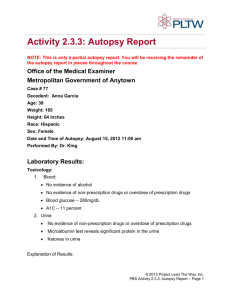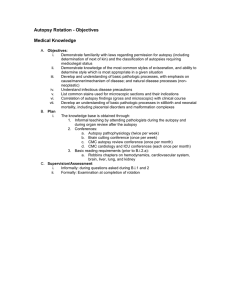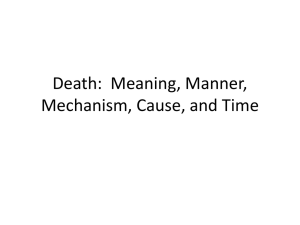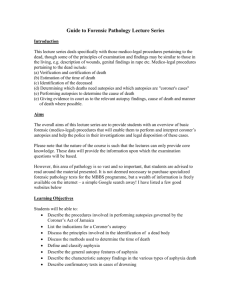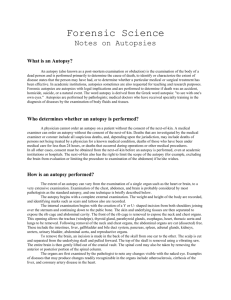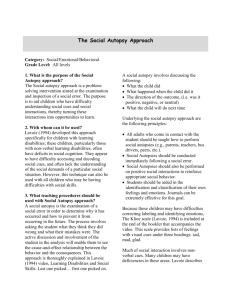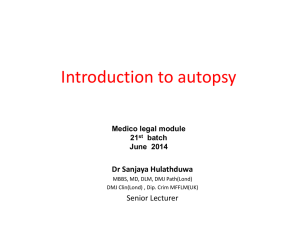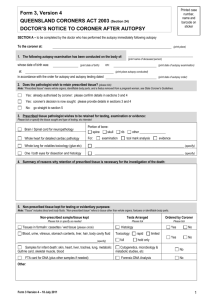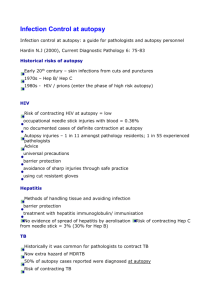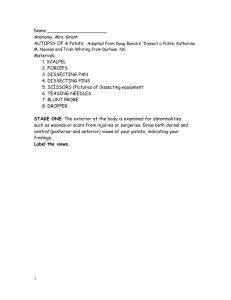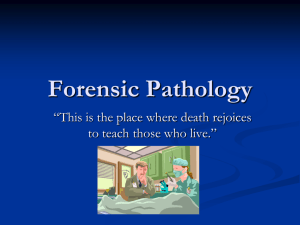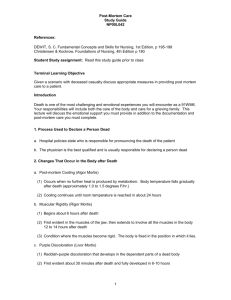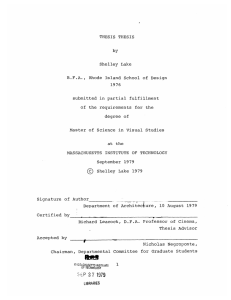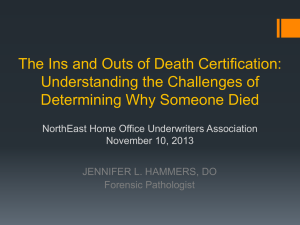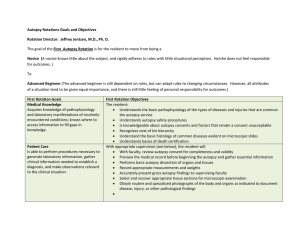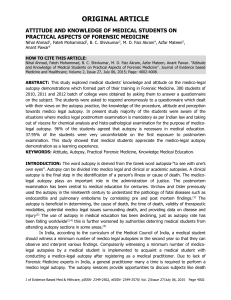Virtual Autopsy Learning Log
advertisement
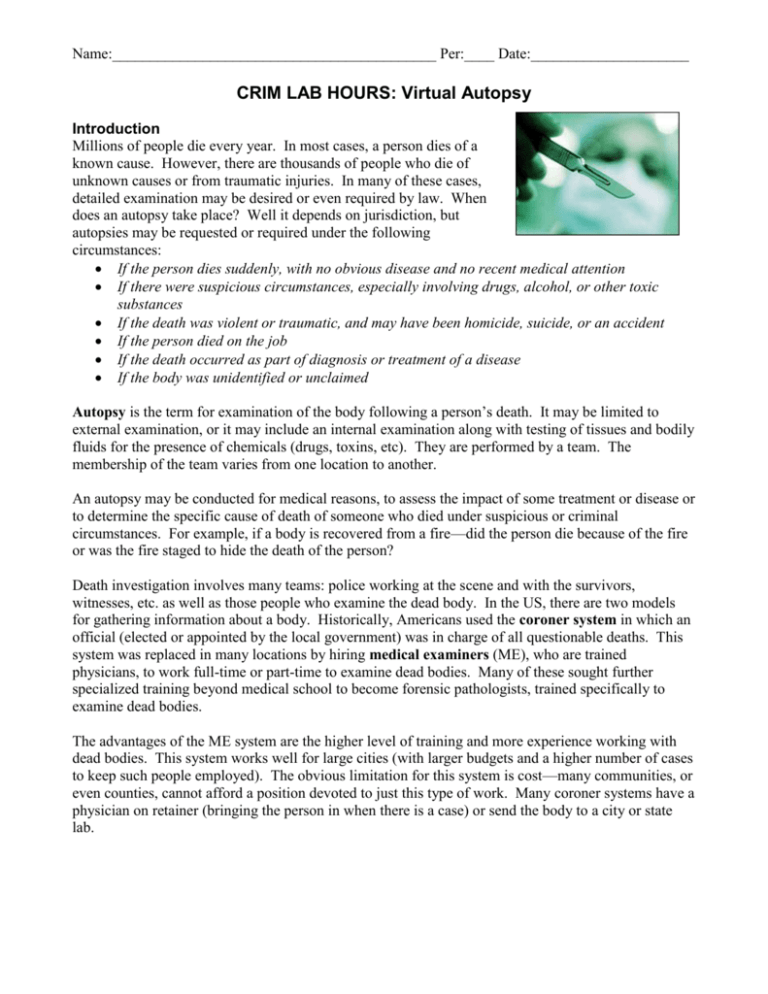
Name:___________________________________________ Per:____ Date:_____________________ CRIM LAB HOURS: Virtual Autopsy Introduction Millions of people die every year. In most cases, a person dies of a known cause. However, there are thousands of people who die of unknown causes or from traumatic injuries. In many of these cases, detailed examination may be desired or even required by law. When does an autopsy take place? Well it depends on jurisdiction, but autopsies may be requested or required under the following circumstances: If the person dies suddenly, with no obvious disease and no recent medical attention If there were suspicious circumstances, especially involving drugs, alcohol, or other toxic substances If the death was violent or traumatic, and may have been homicide, suicide, or an accident If the person died on the job If the death occurred as part of diagnosis or treatment of a disease If the body was unidentified or unclaimed Autopsy is the term for examination of the body following a person’s death. It may be limited to external examination, or it may include an internal examination along with testing of tissues and bodily fluids for the presence of chemicals (drugs, toxins, etc). They are performed by a team. The membership of the team varies from one location to another. An autopsy may be conducted for medical reasons, to assess the impact of some treatment or disease or to determine the specific cause of death of someone who died under suspicious or criminal circumstances. For example, if a body is recovered from a fire—did the person die because of the fire or was the fire staged to hide the death of the person? Death investigation involves many teams: police working at the scene and with the survivors, witnesses, etc. as well as those people who examine the dead body. In the US, there are two models for gathering information about a body. Historically, Americans used the coroner system in which an official (elected or appointed by the local government) was in charge of all questionable deaths. This system was replaced in many locations by hiring medical examiners (ME), who are trained physicians, to work full-time or part-time to examine dead bodies. Many of these sought further specialized training beyond medical school to become forensic pathologists, trained specifically to examine dead bodies. The advantages of the ME system are the higher level of training and more experience working with dead bodies. This system works well for large cities (with larger budgets and a higher number of cases to keep such people employed). The obvious limitation for this system is cost—many communities, or even counties, cannot afford a position devoted to just this type of work. Many coroner systems have a physician on retainer (bringing the person in when there is a case) or send the body to a city or state lab. Procedure: Go to the following website: http://www.le.ac.uk/pa/teach/va/titlpag1.html 1. Click on the “Anatomy & Physiology” link at the bottom, left of the main page. Here, you will get brief tutorials about each of the systems in the human body to help you identify the cause of death based on the symptoms and autopsy results of each case. 2. Click on “Cardiovascular system”. Answer the following questions: a. What is the difference between pulmonary circulation and systemic circulation? b. Define systole and diastole. c. What are the 5 “parts” of a heartbeat? Describe each briefly. 3. Click on “Respiratory System”. Answer the following questions: a. How many lobes comprise the human lungs? b. Describe the mechanics of breathing. How do you inhale? Exhale? c. What are the alveoli? Describe their structure and function. 4. Click on “Central Nervous System”. Answer the following questions: a. Label the parts of the brain (below): b. Color the 4 cerebral lobes on the brain diagram above. Include your color code below: c. Record what each lobe (frontal, parietal, occipital, and temporal) is responsible for controlling (click on the hyperlink for more information on each lobe). d. Circle the area of the brain each cerebral artery supplies blood: anterior, middle, and posterior. What happens if there is damage to one of these arteries? 5. Click on “Genitourinary System”. Answer the following questions: a. What is the function of the kidneys? What is urine? b. What is a nephron? Describe its structure. c. What is the function of the following: glomerulus, proximal convoluted tubule, loop of Henle, and distal convoluted tubule. 6. Click on “Liver & Portal System”. Answer the following questions: a. What are the 5 main functions of the liver? b. What happens to the blood once it drains into the hepatic sinusoids? c. What does the portal venous blood contain? d. Can you palpate (feel) the normal liver? Why? e. Can you palpate (feel) the normal gall bladder? Why? 7. Click on “Gastrointestinal System”. Answer the following questions: a. What is the GI tract? b. What is the function of the esophagus (oesophagus)? c. What are the functions of the stomach? d. What is the function of the small intestines? e. What is the purpose of villi of the small intestine? f. What is the function of the pancreas? g. What is the function of the large intestines? 8. Click on “The Virtual Autopsy” button at the top left to return to the main page. Case #1 1. Read through the patient’s case history. a. What symptoms did the patient present with? b. What was the woman’s medical history? c. What did the examination and test results show? d. What was the progression of the condition? 2. Click on each system on the cadaver on the left to learn more information about the tests run. Which system(s) test results were NOT normal? Describe. 3. Briefly research the symptoms and cause(s) of the following conditions: a. Atherosclerosis b. Brain stem haemorrhage c. Coma d. Duplex ureter e. Epilepsy f. Hypertension g. Ovarian cyst h. Subdural haemorrhage i. Vasculitis 4. What was the cause of death of patient #1? What evidence from the autopsy supports this conclusion? Case #3 1. Read through the patient’s case history. a. What symptoms did the patient present with? b. What was the woman’s medical history? c. What did the examination and test results show? d. What was the progression of the condition? 2. Click on each system on the cadaver on the left to learn more information about the tests run. Which system(s) test results were NOT normal? Describe. 3. Briefly research the symptoms and cause(s) of the following conditions: a. Acute asthma attack b. Hypovolaemic shock c. Anaphylactic shock due to nut allergy d. Anaphylactic shock due to penicillin residue e. Cardiac arrest f. Anaphylactic shock due to bee sting g. Poisoning h. Stroke 4. What was the cause of death of patient #3? What evidence from the autopsy supports this conclusion?


